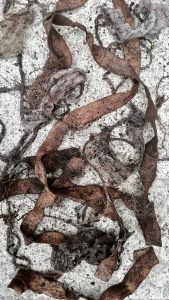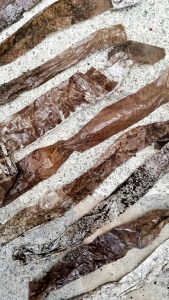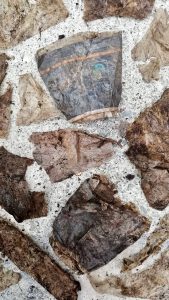Even for an experienced composter, unearthing an old heap can offer a salutary refresher course in the need to treat ‘compostable’ claims with caution.
I never imagined I would see this pair of Y-fronts again. They should be long gone by now, the threadbare organic cotton rotted away, disintegrated beyond recognition into crumbs of dark, soil-building compost – an earthworms’ feast.

The unexpected twang of elastic, catapulting a mouthful of humus, together with a few worms, served as a rude, earth-flavoured reacquaintance. So began another long-overdue lesson in the ever-evolving art of garden compost-making.
This lesson has been brewing for 20 years, ever since I started making compost here. Back then I was a gardener possessed, building huge ‘hot’ heaps as tall as myself, whose scorching hot cores sent plumes of steam into the cool night air.
I composted everything I could get my hands on: piles of bracken rhizomes dug from my new terraces; imported, mouldy straw bales; heaps of cardboard to add ‘browns’ to my mixes; and just about anything else that came into my home or garden that I thought had an outside chance of being transformed into gardening gold – including those worn-out, holed ‘100% cotton’ Y-fronts. So in it all went. It would all, eventually, break down into compost, wouldn’t it? All I’d be left with would be crumbly, soil-boosting manna – right?
A shortage of garden compost this spring compelled me to finally unearth one of my prototype makeshift compost bins: a cylinder of repurposed stock fencing lined – unwisely, it turns out – with synthetic ‘landscape fabric’ (it broke up as I emptied the bin).
So many moons have passed that the top of the heap sported a clump of wild raspberries (my feeble 20-year-old excuse for not emptying it has been a reluctance to deprive small bumblebees of the raspberry flowers). This spring, needs outvoted bees.

Raspberries removed, everything looked promising; I could start decanting the dark gold ready for spreading over my no-dig beds. Minutes later, the elastic which had once held up my undies did its flinging. In its wake sprang a mass of tough, presumably nylon, rot-proof threads, which I teased from the compost. They came away mostly intact and, laid out, you could almost still see the Y. Lesson: ‘100% cotton’ doesn’t apply to any elastic and other trimmings; the cotton itself, being plant-based, was long gone.
Semi-indestructible underwear was just the first of the rot-resistant artefacts to emerge from the heap. Delving deeper, with archaeological precision – and a plummeting feeling – I heard the distinctive crinkly sound of… plastic.
Out came clear and brown streamers of rot-resistant packaging tape, as tough as the day they went in, flapping in the breeze, the cardboard they once bound together now dark humus. Lesson: strip all tape from cardboard before using it – scrunched up – for composting, for sheet mulching, or as a rain-shedding cover on a compost heap.

Some responsible businesses now use recycled paper-based tape, which rots rapidly in a bin or heap; if it tears easily and has a ‘papery’ feel, it’s almost certainly safe to compost. But beware the great deceiver used by one gargantuan mail-order business: seemingly rot-ready paper tape threaded with unrottable, unburnable, indestructible fibreglass – another potential soil micro-polluting disaster in action. Cut the tape free of the cardboard, and put that with non-recyclable waste.
I’m praying for a time when more joined-up, rot-focused thinking finally kicks in, when all garden-related packaging has a one-way ticket to being easy to transform into soil food. I must have had high hopes back when I filled this bin; as I yanked the plastic streamers free, out came more decay-defying detritus, some with its ‘fully biodegradable’ lies still legible. Lesson: treat any ‘biodegradable’ claim with healthy scepticism.
Labelling of what can and can’t be composted has moved on since my bung-it-in-and-see-if-it-rots days, although it’s still sometimes far from clear. ‘Suitable for home composting’ is a signal that it’ll reliably break down over time in a ‘cool’ home bin or heap (one which doesn’t reach steam-belching temperatures – few gardeners ever achieve that in reality).
Some packaging, especially for food, is only designed to be composted on an industrial scale, in closed vessels, where it is exposed to high, controlled temperatures. In your bin or heap, it’s likely to end up as gloopy, part-rotted mush, which is annoying when sieving the ‘finished’ compost. Put any dubious materials marked ‘compostable’ in with the food waste that’s collected from your roadside.
Lesson: we need a clear, comprehensive labelling scheme showing at a glance whether packaging can go straight into a compost bin or heap. One simple, identifiable logo – a cartoon worm would surely crack it – that all manufacturers are compelled to use, if they want to claim that their packaging can have a one-way ride to our soil, would cut confusion, while helping our gardens grow.

The discovery of a flaccid ghost among the dark gold was a reminder that in some areas there has been progress. It took a moment to realise that the skin-like layer of plastic film was the shadow of a disposable cup, its paper layers long since deconstructed by soil life (I also found similar bits of ‘skin’ that I suspect came from the lining of brown paper bird food sacks). Lesson: do a tear test; if there’s a thin, resistant film of stretchy plastic on paper or card, recycle it instead.
The ghost – along with the elastic, threads and other debris determined to resist rot – was, reluctantly, sent on its way to landfill. Nowadays, many of the vessels used for takeaway food are easily compostable at home (check to see if that cup has a one-way ticket to rot – and bear in mind that it might make a decent plant pot first).
Aside from getting a mouthful of soil, becoming ensnared in nylon threads, getting entangled in plastic tape, and being haunted by coffee cups past, I’ve harvested bucketfuls of rich, dark gardening gold. The masses of shredded office paper I vaguely remember adding to the mix, and the tough bracken rhizomes, are no more.
A coarse sieve helped to remove any wayward, rot-resisting bits of debris, along with some still rock-solid peach stones (those are lined up for the next shredder session). I’ve learnt lessons – new and refreshed – about what will, and what won’t, rot down in a compost bin or heap, even years after it went in.
Most important lesson: don’t yank too hard on the next piece of elastic…
Text and images © John Walker.
Find John on Twitter @earthFgardener










